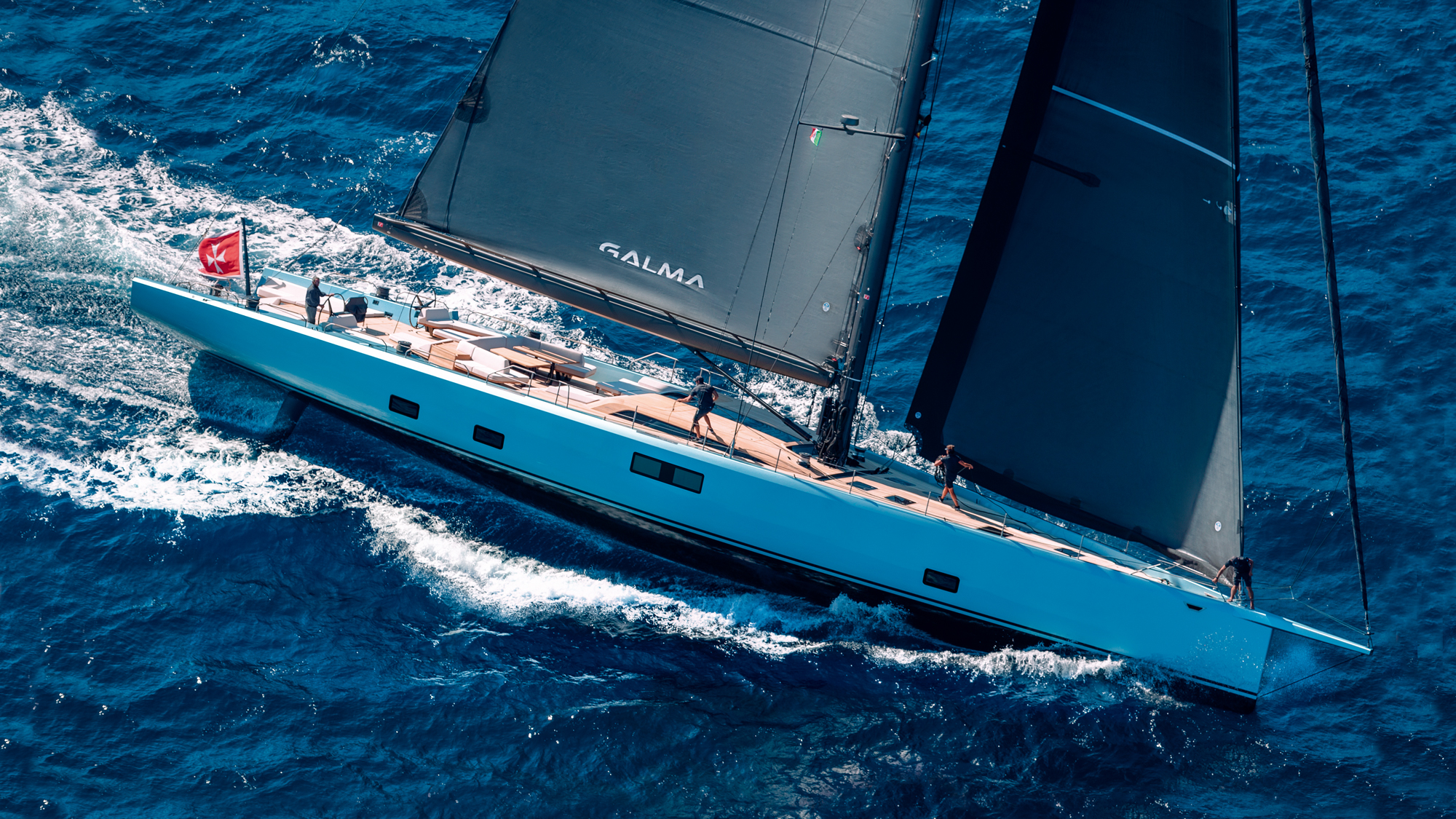The new wallyrocket51 is designed to be the fastest racing boat on handicap in the world – A TP52 beater, a one-design and more. Toby Hodges sails the prototype
Wallyrocket 51 review: Is this the world’s fastest new raceboat (on handicap)?
You have to admire the ambition. A goal to create the fastest race boat in the world (on corrected time) is no small feat, and a particularly punchy thing to claim from the outset, 18 months before splashing the first boat. To then produce a yacht that looks this go-fast good with the Marvel-like heroic name to back it up… It’s brave, it’s brash, it’s bullish. Perhaps only a brand such as Wally could hope to pull it off.
Racing yacht designs are typically fickle things, their potential success often at the mercy of trends and rules. To ensure some longevity, they not only have to prove successful on the water, to give their owners enjoyment and a chance at silverware, but they also need some versatility. Swan, for example, achieves this with its ‘Club’ world of regatta circuits – and by insisting on fitted interiors for after-sales after life.
Wally is another big brand which thinks big. To put its vision in place and try to ensure the Rocket will do what it claims, it involved some heavyweight partners. With the TP52 as the long-proven benchmark in the inshore/coastal Grand Prix scene, Wally took the most successful designers and sailors from this circuit to develop a TP beater. Essentially, it sought a Botin to beat the Botins.
Combine this with founder Luca Bassani’s long-proven forward-thinking ability and the result is a red-hot, water-ballasted 50-footer with trim tab and ultra-efficient hydraulic controls.
Wally used the might of its parent company, the Ferretti Group, to construct these new one-design Rockets in a new top-tech carbon facility. It’s now using the first boat to launch as a prototype, to be wetted most stringently and to sail in the most high-profile regattas in its first season, before the next five on order launch.
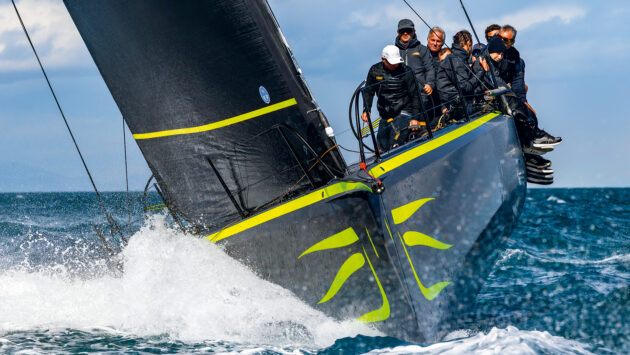
Crew weight and water ballast optimise heel trim. Photo: Gilles Martin-Raget
This first Rocket weighed-in at just over six tonnes light, which is nearly a tonne lighter than a TP52. However, should the stats still not deliver for some reason and it doesn’t prove to be first on handicap in regattas, there are a few other pivotal factors to this 51-footer which could ensure its prosperity.
Firstly, it’s a Wally so it looks rad. Secondly, the aim is for it to be a one-design class for fair owner-driver racing. And then there’s its potential ease of use (comparatively speaking). Bassani’s creations have always promoted ease of handling, and the same could be applied here.
On paper, it’s less expensive to run, as fewer crew are needed thanks to water ballast and hydraulically-operated systems. It’s also been designed with the potential to swap out the coffee grinders for electric winches. “Fast and easy was always Wally,” states Bassani.
Article continues below…
Wallywind 110 review: ‘I’ve never ticked off stretches of coastline so effortlessly’
There are very few times I feel the need to video the scene from a day on the water simply…
The world’s most radical yacht? Onboard Flying Nikka
You might understandably mistake this futuristic craft for another America’s Cup foiler. Yet, although the aesthetics may look similar, Flying…
Pre launch checks
While we don’t often trial full-on race boats, we snapped up this chance. And obviously I crossed every appendage in the hope I might get the full orbital velocity experience. Indeed, during the days in Valencia preceding our spring visit, when the official photos you’re seeing were taken, the crew experienced prime conditions.
However, even Wally can’t choose the weather, and for our day, we were dealt light winds and flat seas. This did offer the chance for the various international media to each take a turn on the helm, both sailing upwind and down. It proved a delightful appetiser which, when you’re dealing with a Grand Prix yacht, is a rarity.
Valencia is the training base for the Django sailing team, who are using Wally’s prototype to develop it in racing conditions before they take the third hull.
“Wally has given us a huge opportunity to fine-tune this boat for the class,” explains Vasco Vascotto, the supremely experienced tactician helping to spearhead this class and sailing team, along with fellow TP52 specialist, the Argentine strategist Guillermo Parada.
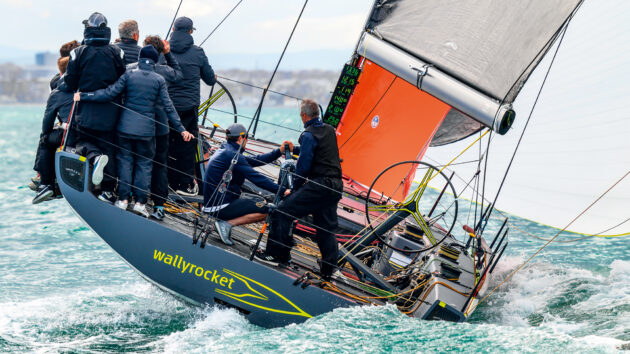
Early trials (and initial races) for the Django sailing team have proven promising. Photo: Gilles Martin-Raget
During our pre-sail briefing they explained that the boat launched with a trim tab on the keel, an appendage which helps negate leeway upwind and reaching, reducing rudder use and drag. They sailed with it for a few days in December before being met with the news on 1 January that the IRC class was doubling the penalty for trim tabs, so they had to take the painful decision to remove it, changing the keel out for the first few regattas this season.
And what a season: Django’s programme includes the Admiral’s Cup and Fastnet Race – surely the most demanding initiation to prove if it is competitive racing offshore? For IRC regattas, they’ll race with 15, “because you get given that crew number so you might as well take it,” explains Parada. For one-design they plan to race with around four fewer crew, a factor which helps Wally to claim it will be a fair bit cheaper to run than a TP.
Rocket fuel
Compared to a TP, the Rocket sports a bit less beam, and chamfers are used for windage reduction (not allowed on TPs). The designers also tried to reduce wetted surface area as much as possible. “But the biggest difference is the weight and being able to compensate this,” Parada explains.
Here he’s referring to the water ballast, with 600lt available on each side, split into two tanks fore and aft. Even with full tanks, that’s still 300kg or so lighter than a TP52, all of which makes the team confident the Rocket will be very competitive, especially downwind and reaching.
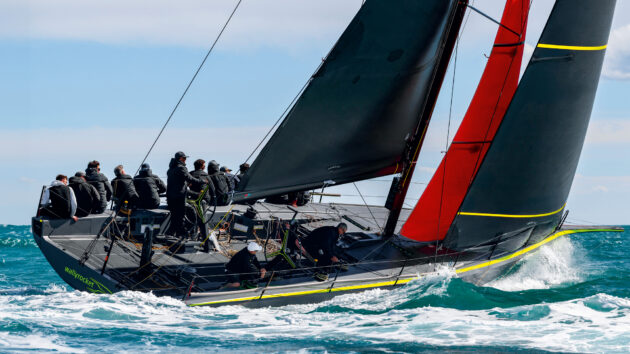
Fully stacked: the Rocket will race in offshore/IRC events with 15 crew but is designed to be controlled with electric hydraulics too, so human power and crew numbers can be reduced. Photo: Gilles Martin-Raget
The tanks take around a minute to fill, seven seconds to transfer between tacks and 40 seconds to dump. I was soon impressed with how these can be used to play with the righting moment and how crew can actively ‘trim’
the ballast. Mastering this and heel angle will be critical.
In fact, our trial conditions were an ideal demonstration, as the wind fluctuated from just 4 knots into occasional double figures so we could witness the difference and the benefits of having no ballast in light airs, up to the full tanks to temper the heel angle upwind. It’s impressive. No crew need move, the trimmer monitors heel angle, decides to flood a tank in seconds, transfers this ballast or dumps it as you round the top mark.
Lift off
Despite a laden boat, nearly half of which was made up of clumsy media, the Rocket quickly shows some potential. While reaching with the J2 at 100° to the apparent wind (a more suitable Code 0 range), I note we’re already near matching its 9 knot polars in just 7 knots true wind speed. Pointing up, we clock 7.5 knots in a knot less at 35° to the true wind. “It’s promising,” Vascotto confirms with a twinkle in his eye.
The trimmer’s display reads three tonnes on the forestay, load shared with the structured luff. The trimmer explains how they trim the backstay before adjusting the jib Cunningham. At this point, we have enough power on to induce 16-18° heel and it’s time to add some water ballast. The Rocket stabilises in attitude and continues to accelerate. It’s a raw, unforgivingly stiff motion.
During my stint on the wheel, we maintain 8.5 knots boat speed upwind in 9.7 knots at 42° to the true wind. It’s so reactive, with instant response and super direct communication to that single blade. The mainsheet trimmer speaks to backstay trim, and I appreciate how you then really feel the latter on the helm.
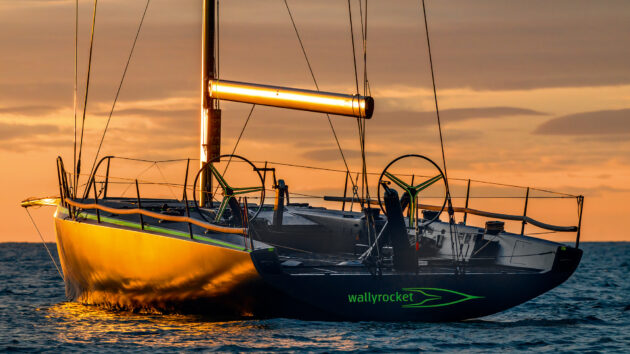
At the end of the day (excuse the cliche), the Rocket is a Wally, and thus, even for a stripped-out racer, oozes style. Photo: Gilles Martin-Raget
While this is translated through a nice amount of pressure on the wheel, it’s also a lot to process, a sensory overload, with constant comms and trimming. I simply focus on keeping it to the best angles and numbers the mainsheet trimmer is calling, yet I’m surprised how much I need to actively steer in these light conditions.
The kite is hoisted and we’re immediately into double figures. This is a training spinnaker, an A2 normally used for bigger breezes and only manually dropped rather than using the super quick string-drop system. Nevertheless, we can match the 10-11 knots true wind at 140° true, accompanied by a cheerful humming sound as the Rocket planes, so easily, and with so little wake. This is one wonderfully slippery hull.
“I’m very, very happy,” grins Luca Bassani, after his first stint on the helm. “The amount of feel really impressed me – you can feel when the backstay is added and the difference the water ballast makes to trim.”
Flight control
The deck layout and control systems are next-level in their ergonomics and ability to adapt to short(er)-handed use. Below the cockpit side decks are mounted neat panels in ideal strategic positions for trimmers to have remote push-button hydraulic controls for various functions. Sheets can obviously be cross-led to optimise crew weight, while multiple winches and functions can be selected to be powered by the coffee grinder. This is linked to a rotary machine below deck, a similar system to TPs, which allows you to use it to pump hydraulic oil pressure.

The WallyRocket boasts more sail area/disp than a TP52 for less wetted surface. Photo: Gilles Martin-Raget
Vascotto says they’ve tried to ensure the Rocket is as dry a boat as possible below decks. He points out how the transverse jib tracks are mounted above rather than through the deck, and that after five days of 20+ knot conditions, just three spongefuls of saltwater found its way inside.
And it is a bare carbon shell inside. I struggle to imagine what it would be like to sail a classic offshore race aboard this. Whether trying to rest in dark pipe cots within this black can, or hiking from the unforgiving deck with its sandpaper-like non-slip, it’s brutal. There are no creature comforts, and any extra weight tolerances were used up on the graphics (Parada’s answer as to why there’s none of the nice foam decking many race boats use these days: “weight – it would have added 3-4kg!”).
Touch down
As we motor back to port I try to gauge the assessments from the pros. “Downwind, it’s a rocket for sure, while today confirmed its light wind ability too,” notes Vascotto.
“It’s simple and fast,” Bassani concludes. “Even in very light airs you move, then in 15-18 knots you’re planing without even a gennaker. So if the boat is successful racing, then we will strongly push for the electric mode – as 15 aboard feels crowded.
“I’m imagining the short-handed ability when the coffee grinders are swapped out for electric power… owners will be able to daysail it with three crew,” he muses. At the same time you can sense Bassani’s frustration with the ratings authorities, and not just for the trim tab penalty.
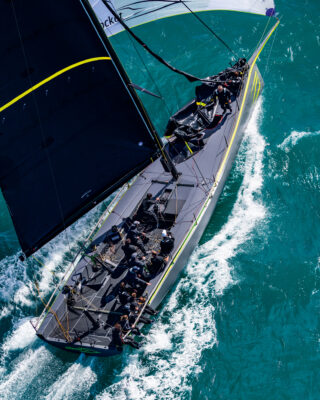
Photo: Gilles Martin-Raget
“The rules are penalising electric winches, which are slower than coffee grinders – it’s crazy!” he reasons, because if you reduce crew, you reduce complexity and cost. Vascotto confirms that for one-design racing they’re looking at reducing crew to 11.
When asked if the world needs another 50ft race boat, he says they “learned a lot from past classes and what we could improve. So although difficult to beat this dimension, at the same time we can make something new.” Vascotto explains how they’re trying to promote value, with comparatively cheap running costs, and by ensuring the Rocket is fast in all conditions and ratings.
“As an example, this is watertight, whereas the TP isn’t. The TP doesn’t have a reef, this does. So whether IRC, in class or coastal, the Rocket can do it.”
This summer should prove the ultimate testing ground. And let’s not forget the Italian fuel which could really ignite this rocketship: the Wally factor.
Wallyrocket 51 specifications
LOA: 15.50m / 50ft 10in
LWL: 15.00m / 49ft 3in
Beam: 4.30m / 14ft 1in
Draught: 3.50m / 11ft 6in
Disp (light): 6,250kg / 13,779lb
Water ballast: 640lt / 1,411lb (each side)
Sail area (upwind): 160m2 / 1,722ft2
Sail area (downwind): 360m2 / 3,875ft2
Design: Botin Partners/Wally/Santa Maria Magnolfi
Builder: wally.com
 If you enjoyed this….
If you enjoyed this….
Yachting World is the world’s leading magazine for bluewater cruisers and offshore sailors. Every month we have inspirational adventures and practical features to help you realise your sailing dreams.Build your knowledge with a subscription delivered to your door. See our latest offers and save at least 30% off the cover price.
Note: We may earn a commission when you buy through links on our site, at no extra cost to you. This doesn’t affect our editorial independence.




